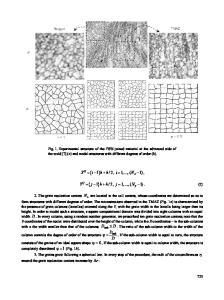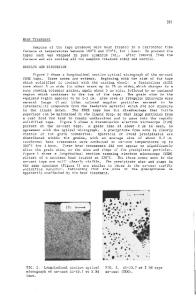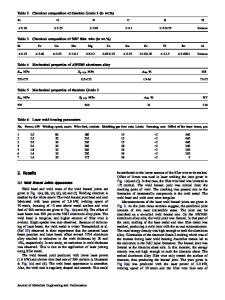Microtexture in the friction-stir weld of an aluminum alloy
- PDF / 8,015,529 Bytes
- 8 Pages / 612 x 792 pts (letter) Page_size
- 80 Downloads / 350 Views
INTRODUCTION
FRICTION-STIR welding is a new solid-phase welding process that potentially offers considerable improvements in the properties of welded aluminum (Al) alloy structures.[1–6] Many organizations have carried out experimental studies on the microstructures,[7–16] corrosion,[17,18,19] and mechanical properties[1–3,6,8,10–14,18,20–22] of friction-stir welds of several series of Al alloys. The friction-stir welds are made in the solid phase with a fine-grained microstructure, exhibiting acceptable fatigue, tensile, and bend properties compared to conventional fusion welds.[1,3,4] The friction-stir process is characterized by frictional heating and plastic flow arising from the rotating tool. The frictional heat significantly affects the microstructure. The authors have systematically examined the microstructures, especially the precipitation sequence, associated with hardness profiles in a friction-stir weld of the precipitation-hardened Al alloy 6063-T5.[14,15] The hardness of the frictionstir weld of Al alloy 6063 was reduced around the weld center. Frictional heating and plastic flow were introduced in the weld by rotation of the welding tool and created fine recrystallized grains and recovered grains in the weld. The hardness profiles depended strongly on the precipitation distribution and slightly on the grain size in the weld. The softening was characterized by dissolution and growth of strengthening precipitates. Postweld aging raised the hardness in the softened region. The hardness increase could be explained by the precipitation sequence in the weld during postweld aging. After the postweld aging, the softened region in the weld had roughly the same hardness as the base material. The authors have described in these studies that frictional heating during the welding has the most significant impact on hardness profiles in the welds of precipitation-hardenable Al alloys, because the volume fraction, size, YUTAKA S. SATO, Research Associate, and HIROYUKI KOKAWA and KEISKE IKEDA, Professors, are with the Department of Materials Processing, Graduate School of Engineering, Tohoku University, Sendai 980-8579, Japan. MASATOSHI ENOMOTO, Leader, SAD Project, and TAKENORI HASHIMOTO, Researcher, R&D Department, are with Showa Aluminum Corporation, Oyama Works 480, Tochigi 323-8678, Japan. SHIGETOSHI JOGAN, Welding Manager, is with the R&D Department, Showa Aluminum Corporation, Sakai City, Osaka 590-8576, Japan. Manuscript submitted August 28, 2000. METALLURGICAL AND MATERIALS TRANSACTIONS A
and distribution of the strengthening precipitates are remarkably influenced by thermal hysterisis. It is difficult to directly observe plastic flow during friction-stir welding. Several studies[23–26] have characterized the plastic flow by flow patterns, the bend of the butt line, or tracer-material distributions in the welds. Li et al.[23,24] have visualized complex flow patterns that developed in the friction-stir weld of Al alloy 2024 to Al alloy 6061 by the different chemical etching of the two Al alloys. Linear stria
Data Loading...











